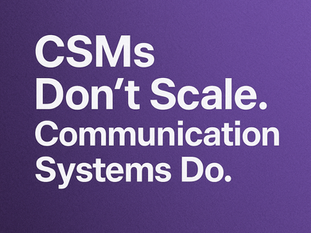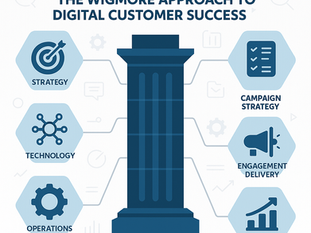
From Friction to Focus: The Case for Targeted Saves and Multi-Channel Orchestration in Modern SaaS
Apr 27
4 min read
0
29
0
By Peter Lyon, Chief Customer Officer & Mark Deegan, CEO – Wigmore IT

Foreword
After leading more than 180 SaaS engagements across every growth stage and region, we’ve seen the common pitfalls firsthand: broken retention strategies, uncoordinated communications, and well-meaning teams working in silos. These aren’t issues of effort—they’re issues of orchestration.
This whitepaper captures lessons learned through Wigmore IT’s work helping SaaS companies transition from fragmented, reactive customer engagement to aligned, data-informed, and scalable success strategies.
The need is clear: targeted saves, governed multi-channel communication, and a shared definition of customer value across functions.
Let’s get into it.
The Retention Illusion
Many SaaS companies claim to be customer-centric, yet their internal workflows and systems betray them.
Health scores are misaligned with real-world outcomes.
Renewal teams spend time on low-risk or unsalvageable accounts.
Marketing, CS, and Support send messages that collide, contradict, or confuse.
In one example, a customer labeled as "red" in the health score renewed at a 90% rate—while many "green" accounts churned. This happens when metrics are built on sentiment, vanity data, or overcomplicated logic rather than signals that correlate with retention.
Worse still, these signals rarely inform customer communications. The result? Emails about new features landing on the same day as unresolved escalations. Or a nurture campaign triggering while a renewal is already in negotiation.
Why Targeted Saves Are Non-Negotiable
Retention is about precision, not coverage. In an environment with thousands of renewals per year, only a small portion are truly “swing” accounts—those who could churn, but don’t have to.
The fix?
Define and align around Minimum Customer Value (MCV)—the least amount of value a customer must experience to be considered retainable.
Build health scores using composite indicators—product usage, sentiment, lifecycle stage—not just one-size-fits-all signals.
Focus save efforts on movable middle segments—typically $2k–$50k ARR—where efficient human or digital intervention delivers ROI.
One organization improved its save rate from 38% to 70% in under six months by refining save targeting and tightening customer segmentation around lifecycle maturity and product adoption.
Multi-Channel Communication: Where It All Falls Apart
Email. In-app. Slack. Salesloft. Support. Legal. Every department has a message—and they often don’t know what the others are saying.
Without orchestration, we see this pattern time and again:
Product sends a release note while Support is managing an active incident.
Marketing triggers an upsell campaign as Finance escalates a payment issue.
Renewals team initiates outreach during onboarding—when the customer is still forming their first impressions.
This isn’t customer engagement. It’s noise.
True orchestration means:
Routing all post-sale communications through a CS platform (not just marketing automation tools) where health, usage, and sentiment data inform timing.
Implementing suppression rules based on support tickets, risk flags, and journey milestones.
Triggering cross-channel cadences (email, in-app, Slack, or phone) based on role, value, and lifecycle.
When companies do this, the results are clear: fewer unsubscribes, higher engagement, more renewals.
Everyone is a Digital Customer Now
The distinction between enterprise, mid-market, and SMB engagement models is blurring. Every customer, regardless of ARR, expects:
Timely and relevant information
Proactive support and guidance
Personalized journeys
The fastest-growing SaaS companies treat every customer as a segment of one. That means:
Creating persona- and usage-based health models.
Orchestrating journeys at the user level, not just the account.
Identifying power users and product champions early—and communicating with them directly.
In practice, this leads to what we call smart-touch orchestration—automated, signal-based communications for most customers, with human overlay where it truly adds value.
Internal Alignment: The Missing Piece
The biggest blocker to change isn’t the toolset—it’s the mindset.
Without alignment, you get:
Competing definitions of “customer health” across functions.
Duplicated or conflicting outreach from different teams.
A system landscape that reflects org charts, not customer journeys.
We often begin our engagements by asking: Do you know who owns your customer communications calendar? Most can't answer.
The fix includes:
A unified customer communication playbook, owned jointly by CS, Marketing, and Revenue Ops.
Shared metrics—like Net Revenue Retention, Expansion %, and Time-to-First-Value—owned across teams.
Central orchestration rules for suppression, triggers, and engagement by persona and lifecycle.
This isn’t about restricting teams—it’s about empowering them with shared visibility, clarity, and purpose.
Lessons from the Field
At Wigmore, we’ve developed a repeatable methodology that works across verticals, product types, and customer maturity levels. Our playbook includes:
Defining Minimum Customer Value (MCV) to guide retention and segmentation.
Redesigning health scores using predictive, outcome-based inputs.
Personalizing multi-channel communications based on real-time customer signals.
Activating automation without losing empathy.
Creating shared ownership of customer outcomes across CS, Marketing, Sales, and Support.
And always: driving decisions from data—not guesswork.
Final Thoughts
In today’s SaaS landscape, revenue growth comes from two places: saving the right customers and expanding the right ones. Both depend on getting your internal house in order.
It’s time to stop chasing every customer. Stop sending every message. Stop treating communication like a department—and start treating it like a strategy.
The path forward is targeted, coordinated, and data-driven. The organizations that get this right won’t just retain customers—they’ll create advocates.
About Wigmore IT
Wigmore IT is a specialist SaaS consultancy and managed services provider. We help high-growth tech companies optimize retention, orchestrate multi-channel customer journeys, and scale operations through smart tooling and strategic alignment. Our team brings deep expertise in Gainsight, Salesforce, Intercom, PX, and enterprise architecture—helping our clients move from reactive firefighting to proactive growth.
With offices in Europe and a growing presence in North America, we work as an extension of your team—designing, implementing, and operating post-sale systems that scale.






